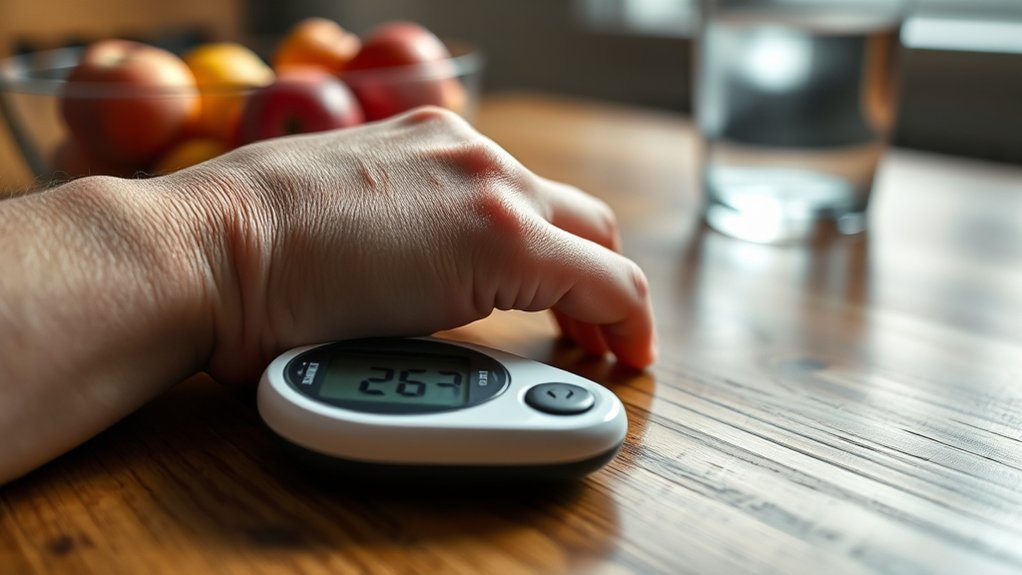Managing your blood sugar levels is essential for overall health, especially if you have diabetes. Understanding the target ranges for fasting and post-meal glucose can help you recognize when something’s off. High blood sugar often leads to symptoms like increased thirst and fatigue, while low blood sugar can cause shakiness and confusion. Knowing these signs enables timely action, but how do you effectively monitor and manage these fluctuations?
Understanding Blood Sugar Targets
When you consider managing your health, understanding blood sugar targets is essential for keeping diabetes in check. Blood sugar targets help you maintain stable glucose levels, reducing the risk of complications.
Generally, the American Diabetes Association recommends fasting blood sugar levels between 80-130 mg/dL and post-meal levels below 180 mg/dL. These targets may vary based on individual circumstances, like age, duration of diabetes, and overall health.
Monitoring your levels regularly allows you to identify patterns and adjust your management plan accordingly. Consistent tracking, coupled with a balanced diet and appropriate medication, enables you to stay within your target range.
Prioritizing these targets can greatly enhance your quality of life and empower you in your diabetes management journey.
Common Symptoms of High Blood Sugar
High blood sugar, or hyperglycemia, can manifest through several distinct symptoms that you should recognize.
One of the most common signs is increased thirst; you may find yourself drinking more fluids than usual.
Increased thirst is a key symptom of high blood sugar, leading to a heightened need for fluids.
Frequent urination is another indicator, as your body attempts to eliminate excess glucose.
Fatigue often accompanies high blood sugar levels, leaving you feeling drained and lethargic.
Additionally, blurred vision can occur due to changes in fluid levels affecting your eye lenses.
Unexplained weight loss, despite regular eating, might also signal high blood sugar.
If you notice any of these symptoms, it’s essential to monitor your blood sugar levels and consult a healthcare professional for appropriate management and guidance.
Recognizing these signs early can help prevent complications.
Recognizing Signs of Low Blood Sugar
Recognizing signs of low blood sugar, or hypoglycemia, is essential for maintaining your health and well-being. Common symptoms include shakiness, sweating, confusion, and irritability. If you notice these signs, it’s important to act quickly to prevent severe complications.
Here’s a breakdown of symptoms and their typical intensity:
| Symptom | Intensity Level |
|---|---|
| Shakiness | Moderate |
| Sweating | Moderate |
| Confusion | High |
| Irritability | Low |
| Dizziness | High |
Importance of Monitoring Blood Sugar Levels
Monitoring blood sugar levels is vital for anyone managing diabetes or at risk of developing the condition, as it provides valuable insights into your body’s response to food, exercise, and medication.
By regularly checking your levels, you can identify patterns that help you understand how different factors affect your glucose. This knowledge empowers you to make informed decisions regarding your diet and physical activity.
Additionally, consistent monitoring can help you recognize trends that may indicate worsening control or the need for adjustments in your treatment plan.
Ultimately, staying vigilant about your blood sugar levels is essential for preventing complications, enhancing your overall health, and maintaining a better quality of life.
Don’t underestimate the impact of diligent monitoring.
Tips for Managing Blood Sugar Effectively
To effectively manage your blood sugar levels, it’s crucial to adopt a holistic approach that encompasses diet, exercise, and lifestyle choices.
Start by monitoring your carbohydrate intake; opt for whole grains, fruits, and vegetables while limiting refined sugars. Regular physical activity, like brisk walking or cycling, enhances insulin sensitivity and helps regulate glucose levels. Aim for at least 150 minutes of moderate exercise weekly.
Additionally, establish a consistent meal schedule; eating at regular intervals prevents spikes and drops in blood sugar. Stay hydrated, as dehydration can affect glucose concentration.
Finally, prioritize sleep and stress management; both can influence your body’s insulin response. By implementing these strategies, you can maintain better control over your blood sugar levels and overall health.
Frequently Asked Questions
How Do Stress and Emotions Affect Blood Sugar Levels?
Stress and emotions impact your blood sugar levels by triggering the release of hormones like cortisol and adrenaline. These hormones increase glucose production and can lead to spikes or drops in your blood sugar.
Can Certain Medications Influence Blood Sugar Targets?
Yes, certain medications can influence blood sugar targets. For instance, corticosteroids may raise levels, while metformin helps lower them. It’s essential to monitor your blood sugar regularly when starting or adjusting any medication.
What Role Does Diet Play in Blood Sugar Fluctuations?
Diet plays an essential role in blood sugar fluctuations. You can stabilize your levels by choosing whole grains, lean proteins, and healthy fats while avoiding sugary snacks and refined carbs that cause rapid spikes and drops.
How Often Should I Check My Blood Sugar Levels?
You should check your blood sugar levels regularly, typically at least four times a day. This helps you stay ahead of fluctuations and manage your overall health effectively, ensuring you make informed dietary and lifestyle choices.
Are There Specific Foods to Avoid for Stable Blood Sugar?
Yes, you should avoid sugary snacks, refined carbohydrates, and processed foods. These can cause rapid spikes in your blood sugar. Instead, focus on whole grains, lean proteins, and healthy fats for better stability.
Conclusion
In managing diabetes, staying aware of your blood sugar targets can make a significant difference. Did you know that nearly 34 million Americans have diabetes, and many are unaware of their condition? Regularly monitoring your levels not only helps you recognize the symptoms of high and low blood sugar but also empowers you to make informed decisions about your health. By implementing effective management strategies, you can maintain stability and improve your overall quality of life.
